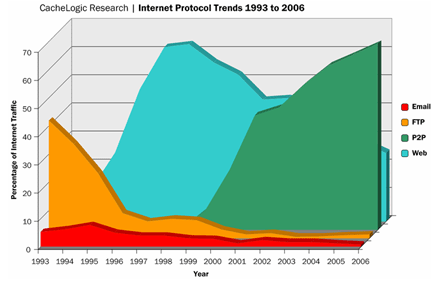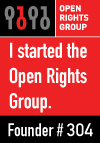Who broke the Internet?
The Internet is broken. You may have noticed some of the signs: slow connections, sluggish downloads, constant disconnections, lost emails, tons of spam. Who broke it, and how can we fix it?
This was part of a very interesting talk by Chris Marsden at BILETA 2008, an earlier version of which can be found on SCRIPT-ed. At the heart of the topic of network neutrality lies the very real fact that there is a serious problem with current architecture. Bittorrent protocol is a wonderful way of transferring large files, but it is resource-heavy. Small number of users can hog as much as 70-80% of the network traffic at any given time. How can this be stopped? Many ISPs have started working on traffic-shaping, throttling, and using other restrictive tools. The justification for these practices is that by throttling bittorrent protocols, it is possible to make sure that the rest of users will not see their service affected. In an unfair situation, placing caps on protocols guilty of hogging the network would be a good idea. To me the "gotcha" moment came when I saw a chart by George Ou, presented at the Network Neutrality hearings in Washington. To me, this is incontrovertible proof that Something Must Be Done:
How can this be stopped? Many ISPs have started working on traffic-shaping, throttling, and using other restrictive tools. The justification for these practices is that by throttling bittorrent protocols, it is possible to make sure that the rest of users will not see their service affected. In an unfair situation, placing caps on protocols guilty of hogging the network would be a good idea. To me the "gotcha" moment came when I saw a chart by George Ou, presented at the Network Neutrality hearings in Washington. To me, this is incontrovertible proof that Something Must Be Done: The problem is of course that current solutions to the problem, such as rate limiting, are inherently unfair, as they castigate the legitimate and occasional bittorrent user as well as the hardcore seeder. It also can be partially circumvented through encryption, although I have heard it on good authority that encryption can be easily shaped.
The problem is of course that current solutions to the problem, such as rate limiting, are inherently unfair, as they castigate the legitimate and occasional bittorrent user as well as the hardcore seeder. It also can be partially circumvented through encryption, although I have heard it on good authority that encryption can be easily shaped.
Bob Briscoe, a researcher at BT, is proposing a change to the network architecture that has been in place since 1986. Current TCP/IP traffic is handled through the additive increase/multiplicative-decrease (AIMD) algorithm, which shapes current congestion through the network. Briscoe and others argue that the current algorithm is unfair as it allows a bittorrent user to open many streams for sharing the same content, while someone browsing will only use one session, which favours the bandwidth hog in detriment of the normal user. The proposed change is to allow for a weighted TCP algorithm, which will allocate similar bandwidth to users, regardless of the number of streams they have open at the same time.
I find Broscoe's proposal elegant and logical, but most importantly, I like the idea of fixing an architectural problem through architecture. Amongst all of the regulatory debates about the subject, I find that the best solution is not to legislate, but to fix the broken protocol.
Now, if I can only get my BT Vision box to work, I will be a happy man.

 del.icio.us
del.icio.us




1 comment:
I agree with your penultimate thought Andres -- all the talk of regulation goes against the open nature of the net, and to my mind the best way of sorting these problems is to let the architects, who understand the technicalities, design new efficient methods of data transport.
Leave the law to the lawyers and the technology to the geeks, say I. Happily I am both :)
Post a Comment